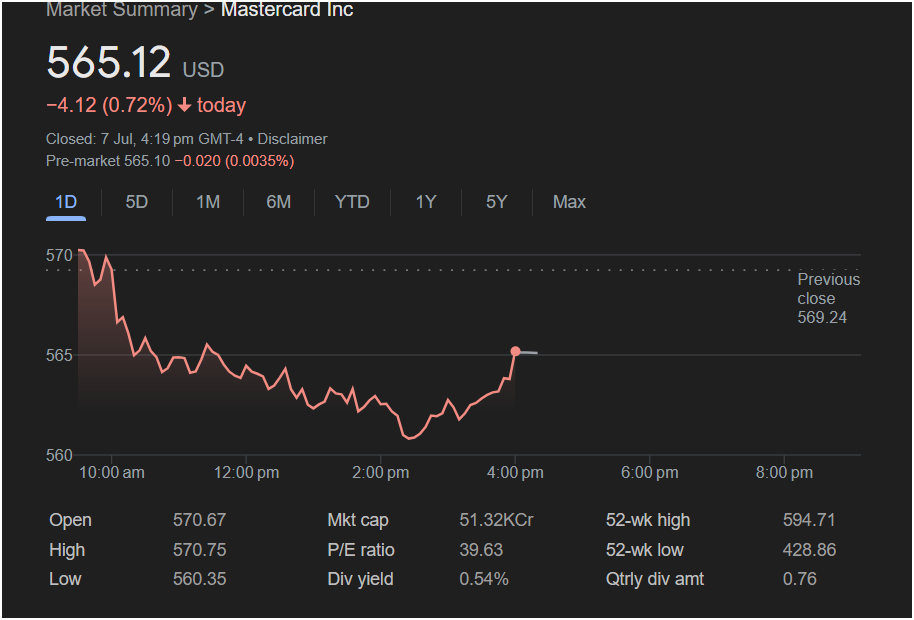Mastercard In-Depth: Stock Pulls Back in Volatile Session, Closing at $565.12 Amid Shifting Market Sentiment

NEW YORK, NY — In a trading day marked by early promise and sustained selling pressure, shares of payments technology giant Mastercard Incorporated (Ticker: MA) concluded the session on Friday, July 7th, in negative territory. The stock closed at
4.12, or 0.72%, from the previous day’s close. The day’s performance tells a story of intraday volatility, where initial investor optimism was eroded, leading to a session low before a partial recovery in the final hours of trading.
This detailed analysis will deconstruct the day’s trading activity, place the stock’s performance within the broader context of its financial metrics and market standing, and explore the fundamental drivers and competitive pressures shaping Mastercard’s trajectory.
Part I: Deconstruction of a Volatile Trading Day
The single-day line chart provided in the market summary offers a minute-by-minute narrative of the battle between buyers and sellers. While a single day’s movement is but a snapshot, it reveals underlying sentiment and technical pressure points.
The Opening Bell and Immediate Reversal:
The session began with a flicker of optimism. Mastercard opened at $570.67, a notable premium over the previous close of
570.75**. This peak, however, proved to be fleeting. The inability to push past this level signaled an immediate exhaustion of buying pressure. This price point effectively became the day’s ceiling, a resistance level that sellers aggressively defended.
The Morning Sell-Off:
What followed the brief peak was a sustained and significant decline. From roughly 10:00 AM onwards, the stock chart depicts a steep downward trend. This sell-off was not a gradual drift but a determined move lower, suggesting that institutional sellers or automated trading programs were actively unloading positions. The stock cascaded through several psychological price levels, breaking below $570, then $565, indicating that the initial bullish sentiment had completely evaporated. This type of sharp morning reversal can be triggered by a range of factors, including profit-taking after a period of strength, a negative turn in the broader market indices (like the S&P 500 or Nasdaq), or sector-specific news affecting financial or technology stocks.
Mid-Day Stabilization and the Session Low:
By midday, the rate of decline slowed, but the downward pressure remained. The stock entered a period of consolidation, trading in a choppy, sideways pattern. This phase represents a period of price discovery where the initial sellers’ momentum waned, but buyers were not yet confident enough to step in forcefully. The bearish sentiment ultimately culminated in the stock hitting its session low of $560.35. This price point represents a significant 1.8% drop from the day’s high—a substantial intraday swing for a mega-cap stock like Mastercard. This low became the critical support level for the day; a breach below this could have triggered a more severe decline.
The Late-Afternoon Rebound:
The final hour of trading, from approximately 3:00 PM to the 4:00 PM close, witnessed a notable recovery. From the low of $560.35, the stock staged a rally, clawing back nearly five dollars to finish at $565.12. This V-shaped or “W-shaped” recovery from the lows is often attributed to several factors:
-
Dip-Buyers: Value-oriented investors and institutions may have viewed the drop to $560 as an attractive entry point for a high-quality company.
-
Short-Covering: Traders who had shorted the stock earlier in the day (betting on a price decline) may have been buying back shares to lock in their profits, creating upward price pressure.
-
End-of-Day Positioning: Portfolio managers rebalancing their holdings before the weekend may have contributed to the buying activity.
Despite this rebound, the stock failed to reclaim the previous day’s closing price, cementing the session as a net loss for shareholders. The pre-market data, showing the stock at $565.10, suggests a quiet and marginally lower start for the next session.
Part II: A Deep Dive into Mastercard’s Financial Vitals
The data points at the bottom of the screenshot provide a crucial foundation for understanding the company’s valuation and investment profile.
Market Capitalization: A Global Behemoth
The screenshot lists the market cap as “51.32KCr”. This notation, “KCr” or “Lakh Crore,” is specific to the Indian numbering system. 51.32KCr equals 51,320 crore rupees. Converting this to USD (assuming an approximate exchange rate of 83 INR to 1 USD) yields a market capitalization of approximately $618 billion. (Note: Publicly available data on mainstream US financial platforms typically places Mastercard’s market cap closer to
520−520-540 billion. The figure from the screenshot may be using a different calculation or exchange rate, but the conclusion is the same: Mastercard is a definitive mega-cap company).
This places Mastercard in the elite tier of the world’s most valuable public companies. Its massive size provides stability, significant influence over the global payments ecosystem, and a place as a core holding in countless index funds and institutional portfolios. This size, however, also means that explosive, rapid growth is harder to achieve than for smaller companies.
Price-to-Earnings (P/E) Ratio: The Price of Quality and Growth
The P/E ratio of 39.63 is a critical valuation metric. It signifies that investors are willing to pay $39.63 for every one dollar of Mastercard’s annual earnings. A P/E of nearly 40 is considered high when compared to the historical average of the S&P 500 (typically 15-20).
This premium valuation is justified by investors on several grounds:
-
Dominant Market Position: Mastercard operates in a virtual duopoly with Visa in the global card payments network. This creates a massive “moat,” or competitive advantage, that is incredibly difficult for new entrants to challenge.
-
High Profit Margins: As a technology and network operator, Mastercard does not bear credit risk (the issuing banks do). This results in an asset-light business model with exceptionally high operating and net profit margins.
-
Secular Growth Story: The company is a primary beneficiary of the long-term global shift from cash to digital payments. This trend provides a powerful and consistent tailwind for revenue growth.
-
Consistent Performance: Mastercard has a long track record of delivering strong, predictable earnings growth.
However, a high P/E ratio also implies high expectations. If the company’s growth were to slow unexpectedly, the stock could be vulnerable to a significant correction as its valuation multiple contracts.
Dividend Yield and Shareholder Returns
The dividend yield is listed as 0.54%. This is a relatively low yield, reinforcing Mastercard’s profile as a “growth” stock rather than an “income” stock. The company prioritizes reinvesting its profits back into the business—funding technological innovation, marketing, and strategic acquisitions—to fuel future growth.
The quarterly dividend amount is $0.76 per share. Annually, this amounts to
3.04pershare(3.04 per share (0.76 x 4). We can verify the yield calculation: ($3.04 annual dividend / $565.12 share price) = 0.00537, or 0.54%. While the yield is modest, Mastercard has a history of consistently increasing its dividend, providing a growing stream of income to long-term shareholders. This, combined with share buyback programs, constitutes its strategy for returning capital to investors.
52-Week Range: A Story of Strength
The stock’s 52-week high is
428.86. The current price of $565.12 sits firmly in the upper echelon of this range.
-
It is only about 5% below its 52-week high, indicating that the stock is still in a powerful long-term uptrend despite the day’s minor pullback.
-
It is a staggering 31.8% above its 52-week low, highlighting the immense positive momentum the stock has enjoyed over the past year.
This positioning suggests strong investor confidence. The 52-week high of $594.71 will now act as a psychological and technical resistance level, while former resistance levels on the way up may now serve as support.
Part III: The Broader Context – Mastercard in the Global Economy
A single day’s stock movement is influenced by far more than just intraday trading dynamics. It reflects the company’s fundamental position within the global economic landscape.
The Indispensable Network:
Mastercard’s core business is not lending money but operating a four-party payment network that connects consumers, merchants, issuing banks (like Chase or Citibank), and acquiring banks (the merchant’s bank). For every transaction that uses its rails, Mastercard earns a tiny fee. When multiplied by trillions of dollars in global payment volume, this becomes a formidable revenue engine. Its primary revenue streams are domestic assessments, cross-border volume fees (which are particularly lucrative and tied to international travel and e-commerce), and transaction processing fees.
The Competitive Arena:
While the duopoly with Visa remains its greatest strength, the competitive landscape is evolving:
-
Direct Competitors: Visa is its mirror image and chief rival. American Express and Discover operate on a different “closed-loop” model but compete for the same consumer and merchant wallets.
-
FinTech Disruption: The rise of digital wallets (PayPal, Apple Pay, Google Pay), peer-to-peer payment apps (Venmo, Cash App), and “Buy Now, Pay Later” (BNPL) services (Affirm, Klarna) presents both a challenge and an opportunity. While these services often still run on Visa and Mastercard’s rails, they are changing consumer behavior and disintermediating the traditional relationship between the card network and the consumer.
-
Regulatory Scrutiny: As dominant players, both Mastercard and Visa face continuous antitrust and regulatory scrutiny worldwide regarding their fee structures. Any adverse regulatory action could significantly impact their business models.
Macroeconomic Sensitivities:
Mastercard’s performance is intrinsically linked to the health of the global economy:
-
Consumer Spending: The company’s revenue is directly proportional to consumer spending. A robust economy with low unemployment and high consumer confidence is a powerful tailwind. Conversely, a recession that curtails spending is a significant headwind.
-
International Travel: Cross-border fees are a high-margin revenue source. The recovery of global travel post-pandemic was a major catalyst for the stock. Geopolitical tensions or health crises that restrict travel can negatively impact earnings.
-
Interest Rates and Inflation: While Mastercard is not a lender, high-interest rates can cool economic activity and reduce consumer borrowing and spending. Inflation can be a double-edged sword: it increases the nominal value of transactions (boosting revenue), but if it gets too high, it can crush consumer purchasing power.
Part IV: Conclusion and Forward Outlook
The 0.72% decline in Mastercard’s stock on this particular Friday, while notable for its intraday volatility, is best understood as minor turbulence within a powerful long-term flight. The late-day recovery from the lows suggests that underlying support for the stock remains firm.
Investors holding or considering Mastercard are weighing the company’s premium P/E ratio of 39.63 against its undeniable market dominance, pristine business model, and alignment with the secular trend of digitization. The key metrics confirm its status as a blue-chip growth stock: it is trading near its yearly highs, and while its dividend yield is low at 0.54%, it reflects a focus on reinvestment for future expansion.
Looking ahead, investors will be closely watching macroeconomic data on consumer health, global travel trends, and the evolving competitive and regulatory landscape in the payments industry. While the journey of any stock is never a straight line, Mastercard’s fundamental position as a critical artery of global commerce ensures it will remain a central focus for the investment community for years to come. The day’s close at $565.12 is simply one more data point in a much larger, ongoing story.






